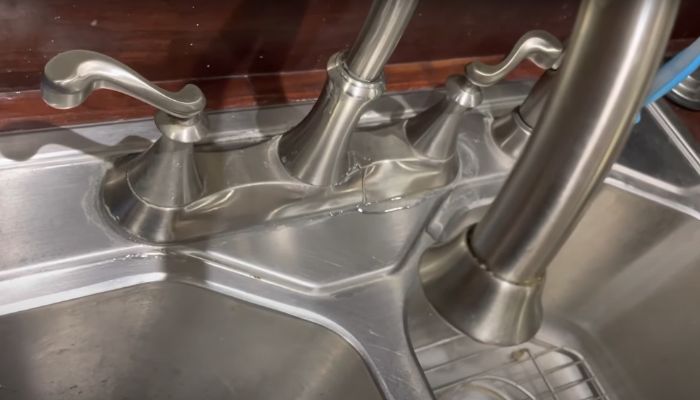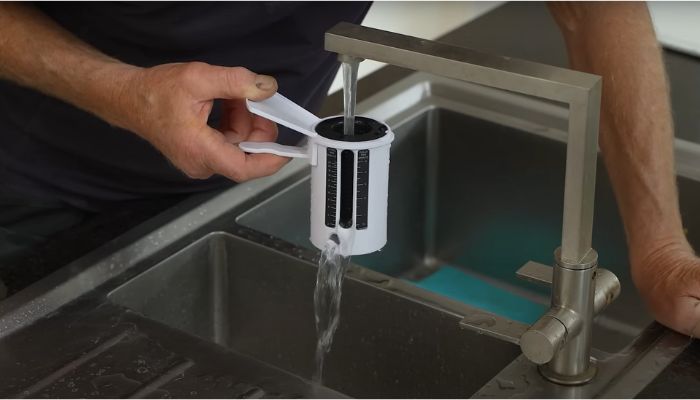Common Faucet Problems And How To Fix Them
Did you know that a typical household utilizes faucets more than 50 times daily? With such a high frequency of usage, it’s natural to see them occasionally output issues. But things can become easy if you know the common faucet problems and fixes.
Low water pressure, leaks, hard-to-turn handles, abnormal operational noises, and dripping are the most common faucet problems. Regular maintenance can help to avoid these issues.
Regarding the fixes, you will need to follow some specific steps for each of them. And you can get all the guidance you require in this discussion. So, read til the very end!
Should You Hire a Professional to Fix a Faucet?
You do not need to hire a professional to fix a faucet. Yes, working with the parts and using different tools to eliminate the issues may initially seem tricky. But if you follow the proper steps, fixing each common problem becomes a piece of cake.
However, if you have zero experience with plumbing repairs and do not have the patience to follow the steps, hiring a professional would be a better choice for you.
But note that you may need to spend anywhere from $45 to $200 for each hour the professional puts into the faucet. And let’s not forget the cost of the replacement parts. Those will add up to the total bill too.
How Long Does It Take To Fix a Faucet?
The time you need to put in to fix a faucet will depend on the problem. For example, a simple repair, such as replacing the O-rings or a washer, can take only a few minutes.
On the other hand, if you are dealing with severe damage, such as too much rust on the main components, you need to invest hours into the issue. In fact, you may even have to replace the faucet if the problem is too severe.
What Tools Are Needed to Fix a Faucet?
Before getting into the fixes, let’s glance at the tools you may need to fix a faucet. This info will help you keep everything prepared and finish the troubleshooting process efficiently. With that said, here’s the list of tools for common problems –
On the contrary, if you are working with a complex problem, you may also need to use the following tools –
Common Faucet Problems and Fixes
Facing any of the common issues stated at the beginning of this discussion? Take a look at how you can fix them –
1. Leaking Faucets
You may already know how a faucet leak can affect your water bill. If you don’t, in short, it has a huge impact! For that reason, you should never ignore leaky faucets.

What Causes Faucets to Leak
Faucets can leak for various reasons. But, in general, these are the common causes-
How to Fix a Leaky Faucet
To fix a leaky faucet, you need to go through these simple steps –
- Close the shut-off valve located at the bottom of the sink
- Plug the sink to make sure that you don’t lose any parts
- Remove the handle of the faucet with a screwdriver or Allen wrench
- Take the washer out of place and check its condition
- If you notice that the washer is worn out, replace it
- Inspect the O-rings and replace them if they are stretched out
- See whether the parts are installed correctly; take the help of the manual if needed
- Lower the flow of the water by adjusting the shut-off valve
Cost to Fix a Leaky Faucet
Faucet O-rings cost anywhere from $1 to $10. And washers can range from $2 to $10. So, overall, you will be looking to spend $20 at max.
2. Low Water Pressure
A sudden drop in water pressure can be worrying. But the issue is not that really challenging to fix. You will soon find out how easy it actually is.

What Causes the Faucet Water Pressure to Drop
Several factors can make the faucet water pressure drop. Among all, these are the most common causes –
How to Fix the Water Pressure of Your Faucet
As stated earlier, you do not need to go through any intricate steps to fix the faucet’s water pressure. Take a look –
- Close the shut-off valve and plug the sink
- Wrap plumber’s tape on the jaws of the pliers and grab the aerator with it
- Rotate counterclockwise to remove the aerator
- Take the handle of the faucet off
- Remove the bonnet nut with an adjustable wrench
- Grab the cartridge and pull it up
- Soak the aerator and cartridge in a vinegar-filled bowl overnight
- Take the parts out and clean them with a brush
- Rinse the aerator and the cartridge and put them back in place
See whether the faucet is offering normal water pressure. If the issue is there, you might be dealing with damaged pipes. In that case, you should inspect the overall plumbing system and make necessary replacements.
Cost to Fix the Water Pressure of a Faucet
If there are no leaks within the pipes, the cost to fix the water pressure will be $0. On the other hand, to replace the leaky lines, you need to spend anywhere from $200 to $300, including the labor cost.
3. Excessive Faucet Noise
Whether it is squeaking or humming, abnormal faucet noises are indeed annoying. And while it may seem like you will need to replace the faucet, you really don’t! Just a few simple steps can resolve the issue.

What Causes Faucets to Make Excessive Noises
When it comes to faucets making abnormal noises, a couple of factors come into play. For example –
How to Fix a Noisy Faucet
These are the steps you need to go through to get a noisy faucet fixed –
- Check the shut-off valve and open it all the way; a half-way opened valve can cause vibrating noise
- Remove the handle of the faucet with an Allen wrench or a screwdriver
- Take the washer out and see whether it is the right size
- If the washer appears to be worn out, you should replace it
- Turn off the main water supply valve and open the faucet shut-off valve
- Flush all the water from the pipes by opening all the faucets in your home
- With all the water within the pipes drained, open the main water supply valve
- Let the water flow for a while to get all the air from the lines out
Cost to Fix a Noisy Faucet
You generally do not need to spend money fixing a noisy faucet. But the tap can start to make excessive noise when it’s faulty. In that case, you will be looking to spend anywhere from $150 to $400 to get a new faucet.
4. Dripping Faucet
A dripping faucet (not leaking) can be the reason why you are paying such a high water bill. To be exact, a faucet that drips 10 drops in a minute can waste nearly one gallon of water per day.

What Makes the Faucet Drip
Your faucet can start to drip water for these reasons
How to Fix a Dripping Faucet
To eliminate the dripping issue of your faucet, follow the steps outlined below –
- Stop the water flow by closing the shut-off valve
- Remove the handle by taking off the screw or protective cover
- Check the washer and replace it if it appears to be worn out
- See whether the O-rings are in the right place; replace them if required
- Lift the old valve seat with a seat wrench and install a new one when it appears to be corroded
- Remove the aerator and faucet cartridge
- Soak the parts in a bowl that’s full of vinegar overnight
- Take the aerator and cartridge out and scrub the loose deposits off
- Install the components in place and reinstall the handle
- Make sure that the handle has the right tightness
Cost to Fix a Dripping Faucet
Typically, there’s no need to shell out any money to get a dripping faucet fixed. But you have to spend $20 max to replace the O-rings and washers.
5. Hard-to-Turn Handle
A sticky faucet handle can be a major issue as it will slow you down while you are taking care of washing and pouring tasks. But like the other common issues, you can tackle this issue without going through any hassles.

What Makes Faucet Handles Stiff
The faucet handle can become stiff after being used for a prolonged time. But there can be other reasons too. Such as –
How to Fix a Stiff Faucet Handle
Here are the steps that you need to follow to make the handle have the normal tightness again –
- Turn off the water flow by closing the shut-off valve
- Take the handle off by removing the protective cover and screw
- Remove the cartridge by taking the nut out with an adjustable wrench
- Soak the handle and cartridge in vinegar for a few hours
- Check the gaskets and replace them if they appear to be worn out
- Take the handle and cartridge out and remove the loose minerals with a brush
- Rinse the parts with clean water and put the faucet back in one piece
How Much Does it Cost to Fix a Stiff Faucet Handle
You might need to replace the gaskets of the faucet to fix a stiff handle. In that case, the highest you have to spend is $10.
Can Common Faucet Problems Be Prevented?
You can prevent most of the faucet problems by taking some simple steps. Here’s a brief description of each of them –
1. Address the leaks as soon as possible
No matter how minor the leak is, you should not ignore it. You should take appropriate measures immediately whenever you notice that the faucet is leaking. And in most cases, you might just have to replace the washer.
2. Install a water softener
If you are living in an area where the water has too many minerals in it, you should consider investing in a water softener system. It will lower the chances of clogs and mineral buildups within the vital parts.
3. Clean the exterior with a clean towel
You can prevent corrosion and rust by simply wiping the faucet with a clean towel after using it. No matter what, do not use harsh chemicals to clean the exterior. They are known to damage the taps.
How to Tell if a Faucet Needs to Be Replaced?
There are some signs that indicate whether your faucet requires a replacement. Let’s go through each of them to give you a clear idea –
- Excessive leakage and dripping: If you can not solve the leak or dripping issue after going through the steps mentioned earlier, it will be time to install a new faucet.
- Rust: Noticing signs of rust or corrosion in all the parts of the faucet? If so, replacing the entire thing is better than getting a replacement for each component.
- Spitting: Generally, a sudden pressure change causes the faucets to spit. But if you are sure that there’s no air buildup within the pipes, the problem is within the faucet. You should replace it.
Do note that replacing a faucet without a plumber’s help is not that challenging. You just need to follow the correct steps and use the right tools.
Final Words
Having sound knowledge of common faucet problems and fixes can save you hundreds. As stated earlier, professionals can charge you anywhere from $45 to $200 per hour.
One simple fix can cost a lot with the replacement parts in the equation! So, instead, just go through the steps discussed in this guide to get the faucet to work normally again.
